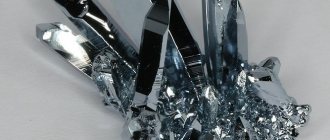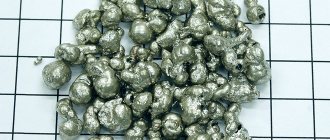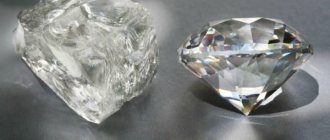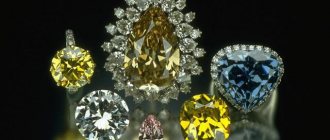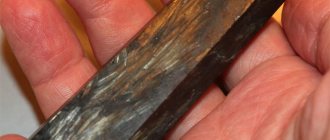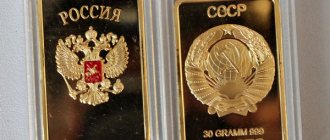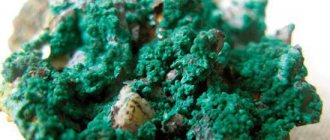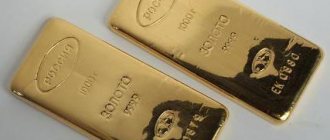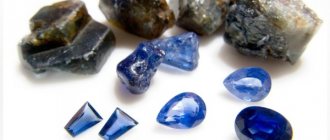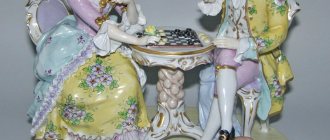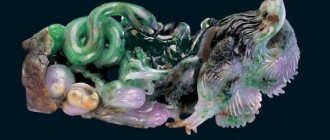The Palladium transcription system is a generally accepted system for writing Chinese words and sentences, based on the Cyrillic alphabet.
The first system of Chinese-Russian transcription was developed by the famous sinologist Archimandrite Iakinf (Bichurin) in 1839.
Iakinf, in the world Nikita Yakovlevich Bichurin (1777 - 1853) - archimandrite of the Russian Orthodox Church, orientalist and traveler, expert in the Chinese language, one of the founders of Russian sinology, the first Russian sinologist to gain European fame.
Later, this system was somewhat modified and popularized by the use of Archimandrite Palladius (Kafarov) and Pavel Popov in the “Complete Chinese-Russian Dictionary”, from where it received the name Palladian (“Palladian”). This transcription system, with minor modifications, is still used today. The Palladian system is now generally accepted and, in fact, the only system used by Chinese-Russian translators. You could say this is the standard from which everyone starts.
History of the creation of the Palladium system
The founder of the first Chinese-Russian transcription system was the famous sinologist Iakinf (dated 1839). Over time, it underwent a number of changes and became widely known thanks to its mention by Archimadrite Palladius and Pavel Popov in one of the Chinese-Russian dictionaries. This is where its name came from - “Palladian” (dated to 1888, Beijing). Having reached the present day, the system has remained in almost its original form and has received generally accepted status. This Sino-Russian transcription system was active long before Pinyin came into use.
It is worth saying that the system does not always manage to correctly convey this or that Chinese sound. The use of the Palladium system for Russian text is strictly mandatory.
Palladium price chart in real time
Palladium is a rare and scarce metal, so its prices have been steadily rising over the past few years. The bullish trend paused in 2022 due to the consequences of the coronavirus crisis - problems in the global economy and the automotive industry in particular:
At the end of 2022, the price of palladium fell by almost 25% - this is the first unprofitable year in a long time. In general, the last 10 years have been successful for palladium; prices have soared many times over. The chart is in many ways reminiscent of the Bitcoin cryptocurrency - there, too, the rate flies up/down by tens and even hundreds of percent. Quotes strongly depend on the state of the global economy; during crises, the graph does not just fall - it flies down at a steep peak.
If we compare prices in 1977 and 2022, we get a yield of about 7% per annum - whatever one may say, a good result. Unfortunately, rate fluctuations do not allow you to simply “invest and forget” about palladium - as the crisis years of 2001, 2008 and 2022 have shown, the metal’s rate can fall by 50% or more at a given moment.
When selecting an investment portfolio, palladium looks best as an addition to a reliable gold investment: according to the calculation of the correlation coefficient, there is practically no connection between the two metals, the value is -0.1 . The connection with stocks is stronger; with the American S&P500 index the correlation reaches +0.8 or higher. So, palladium is not suitable for diversifying the risks of stocks, but as an alternative to gold during a growing economy, it is very suitable.
Is it profitable to buy palladium today? Let's figure it out.
Interesting Facts
Before conducting a deeper analysis of the system, let's consider several features of the Palladium system:
1. The Chinese sound “you” versus the Russian “yu”: the word “friend” is written as “pen-yu”.
2. The Chinese sound “e” (sounds like a more guttural “e”) is transformed into a pure “e”. The sounds “e” and “s” are not allowed in this case. Example: "Mao Z-e-tung."
3. For the Chinese initials “z” and “j”, a replacement in the form of “tsz” has appeared; the use of the sound “dz” is not acceptable.
4. The final “-n” and “-ng” in Russian have acquired the form “-н” and “-н”. This does not take into account the fact that in Chinese these sounds are not softened, and in the second case, with the sound “-ng” the glottis is generally used.
5. Between a syllable that ends with a hard consonant and a syllable that begins with a vowel, a hard sign must be placed. Example: “Chang-anjie.”
6. The suffix ~er (儿), which is added at the very end, has two forms: the original “er” and simply “r”. The letter “r” conveys this suffix immediately after the previous syllable: kun-r, jiao-r, jin-r, wei-r, wanyi-r, zige-r, hua-r. As for changing the syllable to “er”, geographical names play a role here - this is only possible when they are transmitted. An exception can only be when at the end of the previous syllable there is ~e: De-erbukanhe becomes De-rbukanhe.
7. The Chinese sound “hui” received a transcription in the form of “hui” or “hoi” (the latter is typical for the Anhui province), which helps to avoid some curiosity in Russian speech. Many linguists, when translating from Chinese, mistakenly use literal transliteration, which leads to the following: Anh-oi - An-hui, hue-yizu - hui-tzu, etc.
The syllable "hui" can be used to write Chinese surnames, given names, or parts thereof. It is also the name for an entire people and the Chinese dialect "Hui" (徽).
8. And finally, the absence of pre-breathing, so characteristic of most Chinese consonants.
Complete table of transcription of Chinese syllables into Russian
| A | |||
| a - a | ai - ah | an - an | ang - an |
| ao - ao | |||
| B | |||
| ba - ba | bai - bai | ban - bath | bang - ban |
| bao - bao | bei - bay | ben | beng - ben |
| bi - bi | bian - bian | biao - biao | bie - be |
| bin - bin | bing - bin | bo - bo | bu - bu |
| C | |||
| ca - tsa | cai - tsai | can - tsang | cang - tsang |
| cao - cao | ce - ce | cei - tsei | cen - cen |
| ceng - price | ci - tsi | cong - tsun | cou - tsou |
| cu - tsu | cuan - tsuan | cui - tsui | cun - cun |
| cuo - tso | |||
| CH | |||
| cha - cha | chai - tea | chan - chan | chang - chan |
| chao - chao | che - che | chen - chen | cheng - cheng |
| chi - chi | chong - chun | chou - chow | chu - chu |
| chua - chua | chuai - chuai | chuan - chuan | chuang - Chuan |
| chui - feel | chun - chun | chuo - cho | |
| D | |||
| da - yes | dai - give | dan - tribute | dang - given |
| dao - dao | de - de | dei - day | den - day |
| deng - Dan | di - di | dia - dia | dian - dian |
| diang - diang | diao - diao | die - de | ding - ding |
| diu - du | dong - dun | dou - dou | du - du |
| duan - duan | dui - blow | dun - blow | duo - up to |
| E | |||
| e - e | ê, ei - hey | en - en | eng - en |
| er - er | |||
| F | |||
| fa - fa | fan - fan | fang - fan | fei - fey |
| fen - fen (usual fen) | feng - feng (usual feng) | fiao - fiao | fo - fo |
| fou - fou | fu - fu | ||
| G | |||
| ga - ha | gai - guy | gan - gan | gang - gan |
| gao - gao | ge - ge | gei - gay | gen - gen |
| geng - gen | go - go | gong - gong | gou - go |
| gu - gu | gua - gua | guai - guai | guan - guan |
| guang - guan | gui - gui | gun - gun | guo - go |
| H | |||
| ha - ha | hai - hai | han - han | hang - khan |
| hao - hao | he - he | hei - hey | hen - hen |
| heng - heng | hm - hmm | hng - hn | hong |
| hou - hou | hu - hu | hua - hua | huai - huai |
| huan - huan | huang - Huang | hui - hui (hoy) | hun - hun |
| huo - ho | |||
| J | |||
| ji - ji | jia - jia | jian - jian | jiang - jiang |
| jiao - jiao | jie - jie | jin - jin | jing |
| jiong | jiu - jiu | ju - ju | juan - juan |
| jue - jue | jun | ||
| K | |||
| ka - ka | kai - kai | kan - kan | kang - kan |
| kao - kao | ke - ke | kei - kei | ken - ken |
| keng - ken | kong - kun | kou - kou | ku - ku |
| kua - kua | kuai - kuai | kuan - kuan | kuang - kuang |
| kui - kui | kun - kun | kuo - to | |
| L | |||
| la - la | lai - bark | lan - doe | lang - lan |
| lao - lao | le - le | lei - lei | leng - leng |
| li - whether | lia - la | lian - lian | liang - Liang |
| liao - liao | lie - le | lin - lin | ling - ling |
| liu - liu | lo - lo | long - moon | lou - low |
| lu - lu | lü - lyu | luan - luan | lüan - luan |
| lüe - lue | lun - harrier | lün - lun | luo - lo |
| M | |||
| m - m | ma - ma | mai - May | man - man |
| mang - man | mao - mao | me - meh | mei - may |
| men - men (verbal myn) | meng - man (spoken by us) | mi - mi | mian - mian |
| miao - Miao | mie - me | min - min | ming - min |
| miu - mu | mm - mm | mo - mo | mou - mou |
| mu - mu | |||
| N | |||
| n - n | na - on | nai - nay | nan - nan |
| nang - nan | nao - nao | ne - ne | nei - ney |
| nen - nen | neng - nen | ng - ng | ni - neither |
| nia - nya | nian - nanny | niang - nyan | niao - nyao |
| nie - not | nin - nin | ning - nin | niu - nude |
| nong - noon | nou - know | nu - well | nun - nun |
| nü - nude | nuan - nuan | nüe - new | nuo - but |
| O | |||
| o - o | ou - oh | ||
| P | |||
| pa - pa | pai - pai | pan - lady | pang - pan |
| pao - pao | pei - pei | pen - pen | peng - pen |
| pi - pi | pian - pian | piang | piao - piao |
| pie - pe | pin - ping | ping - pin | po - according to |
| pou - pou | pu - pu | ||
| Q | |||
| qi - qi | qia - tsya | qian - qian | qiang - qiang |
| qiao - qiao | qie - tse | qin - qin | qing - qing |
| qiong - qiong | qiu - qiu | qu - qu | quan - quan |
| que - tsue | qun - qun | ||
| R | |||
| ran - jan | rank - jean | rao - zhao | re - same |
| rem - jam | ren - ren | reng - zhen | ri - live |
| rong | rou - zhou | ru - zhu | rua - zhua |
| ruan - zhuan | rui - chew | run - zhun | ruo - jo |
| S | |||
| sa - sa | sai - sai | san - san | sang - san |
| sao - sao | se - se | sei - sei | sen - sen |
| seng - sen | si - sy | song | sou - sou |
| su - su | suan - suan | sui - sui | sun - sun |
| suo - with | |||
| SH | |||
| sha - sha | shai - shai | shan - shan | shang - shan |
| shao - shao | she - she | shei - shay | shen - shen |
| sheng - sheng | shi - shi | shou - show | shu - shu |
| shua - shua | shuai - shuai | shuan - shuan | shuang - shuang |
| shui - shui | shun - shun | shuo - sho | |
| T | |||
| ta - that | tai - tai | tan - tan | tang - tan |
| tao - tao | te - te | tei - tey | ten - shadow |
| teng - ten | ti - ti | tian - tian | tiang - chan |
| tiao - tiao | tie - those | ting - ting | tong - tun |
| tou - tou | tu - that | tuan - tuan | tui - tui |
| tun - tun | tuo - that | ||
| W | |||
| wa - wa | wai - wai | wan - wan | wang - van |
| wao - wao | wei - wei | wen - wen | weng - wen |
| wo - in | wu - at | ||
| X | |||
| xi - si | xia - xia | xian - xian | xiang - xiang |
| xiao - xiao | xie - se | xin - blue | xing - sin |
| xiong - xiong | xiu - syu | xu - xu | xuan - xuan |
| xue - xue | xun | ||
| Y | |||
| ya - I | yai - yay | yan - yang | yang |
| yao - yao | ye - e | yi - and | yin - yin |
| ying - in | yo - yo, yo | yong - young | you - yu |
| yu - yu | yuan - yuan | yue - yue | yun - yun |
| Z | |||
| za - tza | zai - tsai | zan - zan | zang - tsang |
| zao - zao | ze - tse | zei - tsey | zem - tsem |
| zen - zen | zeng - tseng | zi - tzu | zong - zong |
| zou - zou | zu - tzu | zuan | zui - tsui |
| zun - zun | zuo - zuo | ||
| ZH | |||
| zha - zha | zhai - zhai | zhan - zhan | zhang - Zhang |
| zhao - zhao | zhe - zhe | zhei - zhey | zhen - zhen |
| zheng - zheng | zhi - zhi | zhong - zhong | zhou - zhou |
| zhu - zhu | zhua - zhua | zhuai - zhuai | zhuan - zhuan |
| zhuang - zhuang | zhui - zhui | zhun - zhun | zhuo - zhuo |
Palladium system and transcription of place names
The basis for transcribing Chinese topomins is the currently officially accepted geographical names in China. Exceptions are: Beijing and Nanjing (other transcription options for the Chinese language here would be Beijing and Nanjing), Manchu Harbin, Khingan, Qiqihar and many others (an alternative is Haerbin, Xing'an, Qiqihar) and a number of toponyms that relate to regions inhabited by national minorities.
It is permissible to use the sounds “feng” and “myn” (and not “feng” and “men”) when transcribing the toponyms Kai-feng (Kai-feng), Ao-men (Ao-men) and Xia-men (Xia-men). , however, and is considered an outdated practice.
It is noteworthy that the particles in toponyms denoting the words “street” (“dajie”, “lu”, “dao” and others) cannot be translated from Chinese and remain in the whole word, and the particles denoting “square” are omitted.
Traditional Chinese methods of indicating the reading of characters
In the past, two main methods were used to convey the reading of characters in China: 反切 fǎnqiè and 直音 zhíyīn.
Fanze method was that the reading of a hieroglyph was conveyed using two hieroglyphs. The first hieroglyph conveyed the initial sound (initial) of the desired hieroglyph, the second hieroglyph conveyed the final sound (final), for example, the reading of the hieroglyph 南 nán was indicated by the pair 那含 n(à)+(h)án, i.e. nán.
Zhiyin means “direct transcription”, the reading of the character is conveyed through a homophone, for example 螗直音唐, i.e. "螗 is pronounced 唐" (táng). Agree, this is very inconvenient, since you need to know how to read a number of basic hieroglyphs.
Declensions
Words ending with vowels ~o, ~e, ~i, ~u, ~y and diphthongs ~e, ~yu, ~ya, ~ao, ~yao, ~ou, ~ua, ~yue, have no declension .
Geographical names and personal names with ~а and ~я at the end, although they are characterized by case declension, it is still advisable not to use it, in order to avoid confusion with changes in the final syllables. For all cases they must be used in the initial form, for example: Changsh-a instead of Changsh-e, Lyud-a instead of Lyud-e, Wu Chen-Bod-a instead of Chen Bod-e, Wu Sym-y instead of Sym-y and so on.
Words ending in consonants cannot be inflected at all. Russian endings for Chinese names are written together, and not highlighted with an apostrophe or hyphen: Beijing, Shenzhen and others. For feminine names with the same endings, declension is not possible.
Provinces, plains and deserts are inclined in the same way as the Russian word “salt”: in Huang-i, Yunnan-i, Sichuan-i and so on.
Where and how to buy palladium in 2022
When choosing between investing in physical metal or a virtual analogue, I would prefer the latter. Palladium is an industrial metal and few people think about storing it “under the pillow” like gold or silver, so even if the rate rises, it will be difficult to take a profit in your hands. And yet, each option for investing in palladium has pros and cons, so I’ll tell you more about them.
Palladium bars and coins
In principle, buying a palladium bar is not very difficult: you can easily find several thematic sites on the Internet, and residents of Russia can contact one of the large banks. Palladium 999 purity (metal content 99.9%) is sold in bars of 5, 10, 20, 50 and 100 grams and is in protective packaging. This is necessary to preserve the ingot in its original form - any scratch can lead to a decrease in the estimated value of the ingot.
The main problem with investing in palladium bars is not how to make money, but how to realize the profit. The bank only sells bullion, but does not buy it back (at least not from Sberbank), and finding a good deal on the side can be a difficult task. In addition, when purchasing from a bank, you not only pay for the metal, but also VAT - by analogy with other precious metals, the spread reaches 30%. I don't think it's a good idea to lose a third of the bullion's value on the day you buy it. Although, considering how palladium is growing...
It is more profitable to invest in coins made of precious metals in Russia than in bars, since VAT does not apply to them. The assortment is smaller than among gold and silver, but there is still a choice:
Unfortunately, the problem is the same - the bank will not accept your coins back, so the final profit may be significantly lower.
Anonymized metal account
And yet, the opportunity to invest in palladium through a reliable bank exists. of an impersonal metal account began to appear in Russian banks . It is not much different from a standard bank account, there is only one important detail - the account currency is not a ruble or dollar, but 1 gram of metal. Accordingly, if the price of the metal rises, the balance on compulsory medical insurance when transferred in foreign currency also increases, bringing you profit.
Compulsory medical insurance is by far the most popular way to invest in palladium among blog readers. It is not subject to VAT, but deposit insurance does not apply to it. For this reason, it is important to work with a large, reliable bank that will definitely not disappear anywhere in 5-10 years and will issue your deposit. You can open compulsory medical insurance here:
| Bank | Spread | No. by assets in Russia |
| Alfa Bank | 1.5% | 4 |
| Gazprombank | 8% | 3 |
| Sberbank | 9% | 1 |
Considering that investments in palladium have been paying off quickly in recent years, a spread of a few percent does not seem like a big loss. And using such a deposit is very convenient - you can top up from a bank card and manage your account from a smartphone if the bank has an application.
Accent problem
If you transcribe Chinese words and divide them into syllables, the following happens: the vowels ~u ~o ~yu ~e, which are adjacent to other vowels, are included in the non-syllabic category.
Two-syllable names and toponyms always have a final final syllable: Zeng Guof-en, Shangh-ai, Guangzh-ou, etc.
When it comes to three-syllable words, the main stress is usually on the syllable that comes first, and the secondary stress is on the syllable that comes in third: daa-gu-nyan.
Should you buy palladium today?
In order to find a high-quality entry point into the palladium market, the first step is to do a technical analysis of the charts. You can do this yourself or rely on a widget:
Based on information from 25 indicators, one of five forecasts is obtained - from “active sell” to “active buy”. I wouldn’t say that they are perfectly accurate, but they do a good job of showing what’s happening in the palladium market today. Depending on the expected duration of the trade, it is worth selecting the appropriate timeframe:
- up to 24 hours - 1 minute, 5 minutes, 15 minutes;
- 1-7 days - 30 minutes, 1 hour, 2 hours;
- 1-4 weeks - 4 hours;
- 1-6 months - 1 day;
- more than 6 months - 1 week.
Palladium is not very good for long-term trades due to high volatility, so the most suitable time frame, in my opinion, is 1 day.
Another indicator that will tell you whether palladium is expensive or cheap today is the ratio of the price to the dynamics of the American S&P500 index:
When the ratio is at its maximum, it means that palladium is quite expensive today and it is worth looking for opportunities to sell or take profits. Well, if the ratio is minimal, then there is a high probability that palladium is undervalued and it is worth considering purchasing options.
Technical analysis without understanding the global picture of the palladium market does not work very well - it is also necessary to study the factors of supply and demand.
Question of dialects
Dialect forms can only be presented if they are recorded on official papers (for example, maps), displayed in Pinyin documents, or are stable in Russian literature. Let's look at examples:
1. The word “Hong Kong” (if we take the Beijing dialect as an example) turns into “Hong Kong”.
2. Beijing pronunciation changes the sound of the character 六 (from the word 六直) to “lu”: Lu-zhi.
3. Chinese words that are geographical terms, "street", "fortress" and "settlement" change their pronunciation to "gai" and "pu" in the northeastern dialect: Siping-gai, Lengzi-au and so on.
4. Dialectal forms are also applied to some proper names: for example, the name Sun Yixian changes to Sun Yat-sen, and Chen Lianbo to Chan Lim Bak.
Dialects for names and titles used outside the People's Republic of China use transcription systems based on related Chinese topolects.
Phonetic system of Zhuyin Fuhao
In 1912-1913, in the Republic of China, under the leadership of the Chinese linguist Wu Zhihui 吴稚晖 (1865-1953), a phonetic system was created, called 國音字母 guóyīnzìmǔ - the phonetic alphabet of the national language, or 注音字母 zhùyīn zì mǔ – letters for sounds. In 1930, it was renamed 注音符号 zhùyīn fúhào - signs for recording sounds. In its basic version, it includes 37 characters - 21 for initials, 13 diphthongs and finals, 3 medials. After 1949, it continued to be used in Taiwan, where it existed until 2009.
Zhuyin Fuhao Transcription System
Dealing with established exceptions
At the end of our analysis of the system and its role in Chinese transcription, let's pay attention to the established exceptions. The most prominent representatives of this category in toponyms were: Beijing, Nanjing and Harbin. The language from which national autonomies are transcribed is not Chinese, but the language of national minorities.
Another exceptions were the names that entered Russian speech thanks to the intermediary language: Confucius - Kunfuzi.
Well, we got acquainted with the Palladium system. As we said earlier, it is used only in Russian. English-speaking countries take as a basis another transcription system, the founders of which are Thomas Wade, its direct developer, and sinologist Wade Giles, who improved and created the dictionary.
| To title page | December 11th, No. 2 |
Resurrection of Palladium.
Prolegomena. “Unlike writing English words in Russian letters, where there are two approaches - transcription and transliteration, for Chinese words there are clear formalized rules that it would be useful for modern journalists and proofreaders to know (pre-perestroika proofreaders knew them).
These rules are based on the transcription system of Father Palladius (Kafarov), a priest of the Russian Orthodox Mission in Beijing, created in the 19th century. The system, despite its venerable age, still serves; According to some estimates, Palladium’s transcription is the most successful of the foreign transcriptions of Chinese words, conveying the sound closest to the original.
I think that such an assessment has some justification, because I witnessed how some of my compatriots pronounced Chinese words in full accordance with the Palladian system (well, they were too lazy to practice true Chinese pronunciation, laziness!), and the Chinese understood them completely. Palladius's transcription is officially recognized by Chinese linguists; it is necessarily used in Chinese-Russian dictionaries, including those published in China. "(https://www.daochinasite.com/study/spelling.shtml. My italics - B.P.)
A good quote, good words, God bless them!.. Unfortunately, these words are more like a spell than a description of reality. Try to disagree, and I will immediately ask you to show me at least one dictionary on the Internet with the transcription of Palladium and, honestly, I will be grateful to you if you show me one. Due to triviality, I just ask you not to refer to (https://www.daokedao.ru/2010/06/15/xren-vam-a-ne-palladij-za-pol-limona/)
CHINESE-RUSSIAN DICTIONARY compiled by FORMER HEAD OF THE BEIJING SPIRITUAL MISSION ARCHIMANDRITE PALLADIUS and SENIOR DRAGOMAN OF THE IMPERIAL DIPLOMATIC MISSION IN BEIJING P. S. POPOV. BEIJING. TYPOGRAPHY TUN-WEN-GUAN. 1888
Indeed, it reads like good literature. At random:
“愛 Ai. To love, to make peace. | 恤ai xu to feel sorry for someone; to do charity. | 惜 ai si to regret something, skimp on something.| 憐 ai lian condolences. | 私 ai sy affection is exclusive, narrow, like the love of a son for his mother, in primitive times, when children knew only their mother and not their father (Shang Tzu). | 辛 ai xing to fall in love, to become addicted to someone.”…
This is not a text, this is a song...
But using it in pdf is equivalent to dividing on accounts (does anyone remember such a device, a kind of “business machine”?). I am forced to say, unfortunately, that the venerable monk died... And he is alive only in the memories of his apologists, of whom also remain... It’s a pity. Sincerely. For the Russian ear, tongue and mind there can be nothing more useful and attractive than transcription into Russian in Russian letters. This is an axiom. Based on this axiom, I will try to make my own modest contribution to the great cause of resurrecting Archimandrite Palladius, who died untimely just “at the entrance” to the Network.
The second starting point for the proponent of “software for the lazy” is the greater “economy” of Palladium transcription compared to the widely used Pinyin. In 411 Chinese syllables, “Pinyin” has 1330 letters, “Palladium” - 1264, respectively, the average Pinyin syllable has 3.2360 letters, and the average palladium syllable has 3.0754. The difference is not great, but with a couple of “magical manipulations” it can be catastrophically increased and the average “palladium-style” syllable can be increased to 2.73 and even 2.5 with a maximum syllable of 3 characters, and this is already close to Zhuyin, with its “syllable " in 2.3 characters. For phonetic input of hieroglyphs, this may be critical. With such a difference, I think there is no point in assessing the frequency of occurrence of syllables.
It is these “magic manipulations” that we will now deal with. At the same time, please take into account that I am not a philologist, not a specialist in phonetics, especially in Chinese phonetics, and I immediately warn that I do not carry out my manipulations with “Chinese sounds”, of which I have not heard many in my life, and have reproduced even less, and with the recording of Chinese sounds using Palladium transcription, i.e. with letters of the Russian alphabet. In order not to confuse “God’s gift with scrambled eggs,” and not at all out of disdain for phonetic terminology, I will use my own words, the meaning of which is either transparent or will be explained as I use them.
So, forget about “initials,” “medials,” and “finals” for the moment. So far we only have “syllables” and “sounds”. “Syllables” are stable combinations of “sounds”, designated in writing by “symbols” (hieroglyphs in the original) or “letters” (when transcribed into Russian). It is clear that when defining a “syllable” the symbol is primary in relation to the letter. For example, 隶 - “li”, “li” (there are no “tones” yet, I haven’t said this word yet) one “syllable” because in Chinese it is written with one character, and not because in pinyin and palladium it is written with one syllable. And 皇 - “huang”, “huang” is also one syllable, although in transcriptions it consists of two. I am boring you so that your Russian ear will not be offended in the future by statements like “the syllable juan.”
When considering the entire set of Chinese syllables (remember the convention of the word “all”), recorded in Palladian transcription, the “average”, “normal” or “ordinary” syllable can be represented as a certain structure consisting of three components. Let’s call them simply and without pretension: “1st”, “2nd” and “3rd”, so as not to be confused with the mentioned “initial”, “medial” and “final”. The 1st component of a regular syllable is always a consonant or a pair of consonants. There are 17 consonants in palladium: b, c, d, d, g, k, l, m, n, p, s, t, f, x, c, h, w. In an “unusual” syllable, the 1st component may be missing. Then the syllable begins immediately with the 2nd component, which is the “main”, “syllable-forming” and is always present, without it there is simply no syllable. This component is a vowel sound or, if you prefer, a “set” of vowel sounds. He not only “forms” a syllable, but also colors it with “tone”, “tones”. Well, you yourself know everything very well about tones. Palladium has 9 vowels: a, e, i, o, u, y, e, yu, i. The 3rd component is also “optional” and may be absent. But, if it does occur, it is represented only by the consonants “n”, “soft n” (“н”) or “disagreement” “y”. In addition, Palladium uses “ъ” to eliminate uncertainty at the boundaries of syllables in “two-syllable” words and a special sound “er” (“erization of finals” as “materialization of spirits”: why the non-consonant “zh”, as in other cases, let them explain to you sinologists).
Finally we get to the tricks. Focus first. The soft sign (“b”) in the current version of Palladium is used only in conjunction with “n” as “soft n”. Why not “merge” these two characters together and add a new letter “n” to the list of consonants? And at the same time, do the same operation with the “set” of vowels “tsz” and “zh”. As a result, a new group of letters will appear in the complete set of Palladium letters, representing in writing the “composite” sounds “n”, “tsz” and “zh”. Let's call these sounds (and the letters that represent them in writing) “composites.” For clarity, we will call the remaining sounds “simplites” (can you guess why?). Such a simple manipulation leads to the fact that the average number of letters, with an increase in the set of letters by only 2, leads to the fact that the size of the average Palladium syllable drops to the promised 2.73 letters with a maximum syllable of 4 letters, which is already noticeably less than pinyin.
If we go even further, we come to the second focus. The 2nd component of a syllable is often represented by a “set” of vowels, some of which also form stable sound combinations. I am careful not to call them “diphthongs” so as not to tease the geese, especially since this does not “fit” well into “phonetic terminology”. Let's call them “consonantal composites.” There are 8 of them: ao, io, ou, ua, oo, yua, yue, yao. Of these, in three (ao, ou, yao) the first vowel is “toned”, and in the remaining 5 (io, ua, uo, yua, yue) the second one is “toned”. (It is interesting that the vowel composites of the first group of “tinting” always complete a syllable and do not “allow” either “y”, “n”, or “n” after them; this can be interesting when implementing “phonetic input”).
The total “revived” Palladium can be presented in the following table:
| vowels | consonants | dissenters | ||||
| simplites | composites | simplites | composites | simplites | composites | |
| "tinting" | ||||||
| 1st component | 2nd component | |||||
| A | b | th | ||||
| ao | V | er | ||||
| e | G | ъ | ||||
| And | d | |||||
| and about | and | |||||
| O | To | |||||
| OU | l | |||||
| at | m | |||||
| wow | n | |||||
| woah | no | |||||
| s | P | |||||
| uh | With | |||||
| Yu | T | |||||
| Yua | f | |||||
| Yue | X | |||||
| I | ts | |||||
| yao | tsz | |||||
| h | ||||||
| zh | ||||||
| w | ||||||
Focuses are focuses, but there is also a need to indicate tones. The first, most obvious solution is the number at the end of the syllable. Why not?.. Maybe someone will like it, because they use this method in pinyin. The second is diacritics. Its pros and cons. More elegant, easier for those with “developed little fingers” (to press modifier keys), but requires major changes in the font and keyboard.
There are two problems, as with everything in Russia: the font and the keyboard. Well, we were unlucky with the language...
In the Cyrillic section of Unicode, alas, there are not enough letters with diacritics. Of course, you can pick it up “by string”, as they did with pinyin, but are you not surprised by the sorting result when a syllable in different tones is sorted in the following order: 2nd, 4th, 3rd, 1st?
“PhoneticList (Ch-Ch) (for ABBYY Lingvo x3 version). Dictionary of pronunciations for the New Chinese-Russian Dictionary. © “Russian Language Media”, 2004, Kotov A.V. 23 thousand articles.
The Chinese Phonetic Dictionary is a list of 23 thousand Chinese words in Pinyin transcription. Selected from the New Chinese-Russian Dictionary into an auxiliary dictionary to provide electronic search for Chinese words by their pronunciation.”
Unfortunately, the performers are not indicated, but they should have a monument! Hand-to-hand sorting of such an array is only possible out of despair. And therefore mistakes are forgivable when the syllables in the index are sorted in the order of 1st, 2nd, 4th, 3rd...
The simplest and most logical way out is to allocate a separate section in Unicode for Palladium (by the way, for Pinyin too), and “draw” fonts and keyboard layouts for this section. I'm afraid this is probably the most fantastic solution. You can communicate with the guys from the Unicode Consortium with their pace of acceptance and consideration of applications only if you are a young optimist, and I, an old realist, can hardly wait for that happy moment when Russian characters indicating tones with diacritics will appear along with the “bells” already present in Unicode and whistles” such as card suits or dominoes symbols. And if you don’t make jokes, then why isn’t this a task for heads of departments, deans of faculties and rectors of institutes of all kinds of oriental studies? They love and know how to communicate with guys from all kinds of commissions, they have the opportunity to “recruit” students from related departments, faculties and institutes under the plausible pretext of writing coursework, diplomas, dissertations for the development of fonts, keyboards and similar things that a “practitioner” cares about Sinologist” doesn’t care. Won't they be ashamed if people start using “homemade” fonts and keyboards?..
Well, God be their judge. We need a solution here and now. Therefore, the decision to draw a font and prepare a keyboard layout for Palladium is less fantastic, although it looks “wrong”. There is a special area in Unicode: the Private Use Area, a fair amount of area where you could push the devil, not just a monk. Let Palladium live there until someone “in power” and called upon to worry about the state of Sinology (if you fantasize, ... maybe even some academician ...) starts knocking on the above-mentioned Consortium. Who would have recommended this to this academician?... Maybe look for another font designer who would agree to draw the necessary symbols better than I did in the first version of the font and would take care of “patent purity”, which, alas, I cannot guarantee condition. This must be a person who understands “why normal people “steal” software products” and is ready to distribute the finished product under the terms of the NeGnu license. It is clear that both the set and the outline of the “squiggles” I have drawn so far are a subject of discussion by all interested parties. (By the way, it is worth noting in parentheses that by default the planned font simply must be called “Palladium”).
As always, the devil is in the details. To use diacritics, you need to be able to enter 5 “modifications” for each toned vowel, which means you need to use 4 modifier keys. The “simplest” solution is to draw a new keyboard layout. There is a simple and effective tool for this - Microsoft Keyboard Layout Creator 1.4. Drew. Now, with this keyboard of ours, we’re getting into a bunch of applications... It turns out that fashionable (and convenient!) “hot keys” in most cases cannot be disabled or reassigned, and they work regardless of the input language. I press “Ctrl + I”, “Ctrl + Z” works (for example, in Notepad). Developers know better than us who needs what. Often Ctrl and Alt do not work as modifiers, although sometimes they can be “deceived” by the combinations “Shift + Ctrl” and “Shift + Alt”, but this is an additional press, therefore reducing the input speed (and we remember that for the lazy there is an input speed parameter second in importance after convenience). Therefore, it makes sense to look for a tool that gives full access to customizing hotkeys. For example, Notepad++. I was able to disable everything I needed in it in 10 minutes without reading any “instructions.” In Word, “interfering” hotkeys are easy to disable, but Ctrl and Alt will not work (Microsoft also knows better than us what we need), we will have to “treat” them with macros. By the way, in Word you can probably get by with macros alone, without a keyboard, just a font with diacritics. But, in most cases, all this can be found out only by “scientific poking”, and this requires some kind of implementation, which we will turn to in the next article.
| To title page | Top of page | December 11th, No. 2 |
Properties and samples of metal
Palladium is close in its characteristics to its neighbors in the periodic table. The properties of the metal allow it to be compared with silver - in appearance and weight, and with platinum - in chemical parameters. Pure metal has a silvery-white color and a density of just over 12 g/cm3. The latter physical property gives Pd an advantage in jewelry: massive palladium jewelry will weigh much lighter than platinum or gold.
In its pure form, Pd is a soft metal; jewelry is not made from such a material. Products made from a pure element will not withstand even a small mechanical load. Jewelers use certain samples of palladium in their work. What are they? In Western countries, the 950 standard of precious metal is quite common, in which 5% ruthenium or copper is added to 95% of the main element. Nickel is also used as a component of the alloy that can increase the hardness of the alloy. In Russia, 500 and 850 samples of metal have been approved; palladium is combined with silver and nickel. 850 standard can be made of Pd and copper. The resistance to wear of jewelry made from such alloys exceeds the characteristics of products made from gold and silver.
Pd as a metal is distinguished by its malleability and ductility, thanks to which it can be processed in any of the following ways: casting, soldering, polishing, engraving. The material is drawn into wire and can be rolled into foil.
Palladium as an element is distinguished by the chemical inertness inherent in all platinoids, but among the metals of this group it is the most active. Under normal natural conditions, it does not react with other substances, but dissolves in aqua regia, hot concentrated sulfuric and nitric acid. Pd can form compounds with chlorine, iodine, bromine, fluorine, sulfur and silicon. When heated in air, the metal becomes covered with an oxide film and becomes dull; under normal operating conditions, palladium products will not darken.
In terms of its chemical properties, Pd is recognized by experts as a good catalyst, so the main consumers of the element are the chemical and automotive industries.
Physical properties of palladium:
| 400 | Physical properties | |
| 401 | Density* | 12.023 g/cm3 (at 20 °C and other standard conditions , state of matter – solid), 10.38 g/cm3 (at 1554.9 °C and other standard conditions , state of matter – liquid) |
| 402 | Melting temperature* | 1554.9 °C (1828.05 K, 2830.82 °F) |
| 403 | Boiling temperature* | 2963 °C (3236 K, 5365 °F) |
| 404 | Sublimation temperature | |
| 405 | Decomposition temperature | |
| 406 | Self-ignition temperature of a gas-air mixture | |
| 407 | Specific heat of fusion (enthalpy of fusion ΔHpl)* | 16.74 kJ/mol |
| 408 | Specific heat of evaporation (enthalpy of boiling ΔHboiling)* | 358 kJ/mol |
| 409 | Specific heat capacity at constant pressure | |
| 410 | Molar heat capacity* | 25.98 J/(K mol) |
| 411 | Molar volume | 8.851 cm³/mol |
| 412 | Thermal conductivity | 71.8 W/(mK) (at standard conditions ), 71.8 W/(mK) (at 300 K) |
| 413 | Thermal expansion coefficient | 11.8 µm/(MK) (at 25 °C) |
| 414 | Thermal diffusivity coefficient | |
| 415 | Critical temperature | |
| 416 | Critical pressure | |
| 417 | Critical Density | |
| 418 | Triple point | |
| 419 | Vapor pressure (mmHg) | |
| 420 | Vapor pressure (Pa) | |
| 421 | Standard enthalpy of formation ΔH | |
| 422 | Standard Gibbs energy of formation ΔG | |
| 423 | Standard entropy of matter S | |
| 424 | Standard molar heat capacity Cp | |
| 425 | Enthalpy of dissociation ΔHdiss | |
| 426 | The dielectric constant | |
| 427 | Magnetic type | |
| 428 | Curie point | |
| 429 | Volume magnetic susceptibility | |
| 430 | Specific magnetic susceptibility | |
| 431 | Molar magnetic susceptibility | |
| 432 | Electric type | |
| 433 | Electrical conductivity in the solid phase | |
| 434 | Electrical resistivity | |
| 435 | Superconductivity at temperature | |
| 436 | Critical magnetic field of superconductivity destruction | |
| 437 | Prohibited area | |
| 438 | Charge carrier concentration | |
| 439 | Mohs hardness | |
| 440 | Brinell hardness | |
| 441 | Vickers hardness | |
| 442 | Sound speed | |
| 443 | Surface tension | |
| 444 | Dynamic viscosity of gases and liquids | |
| 445 | Explosive concentrations of gas-air mixture, % volume | |
| 446 | Explosive concentrations of a mixture of gas and oxygen, % volume | |
| 446 | Ultimate tensile strength | |
| 447 | Yield strength | |
| 448 | Elongation limit | |
| 449 | Young's modulus | |
| 450 | Shear modulus | |
| 451 | Bulk modulus of elasticity | |
| 452 | Poisson's ratio | |
| 453 | Refractive index |
